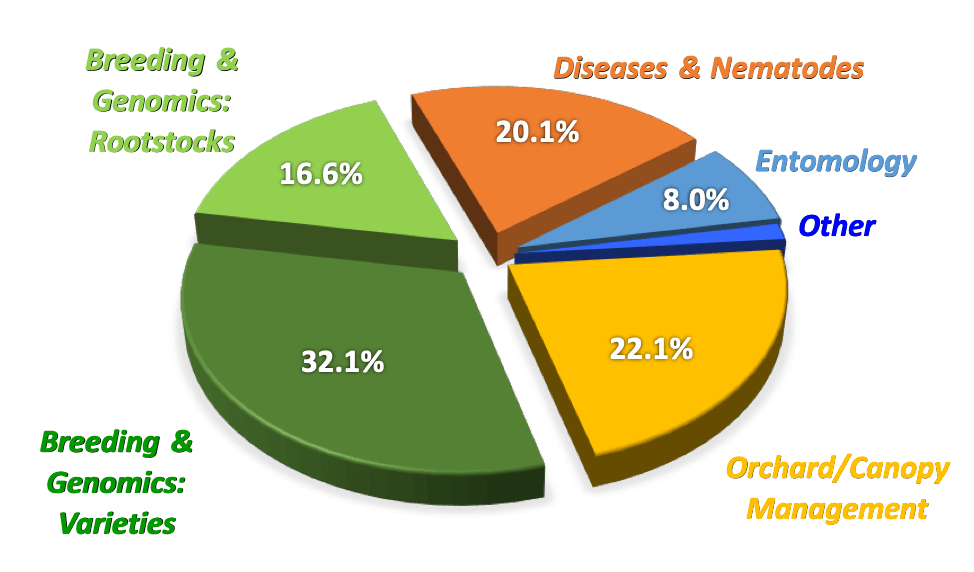Walnut production research goes back over five decades. Each year, the California Walnut Board’s Production Research Committee recommends projects for funding based on industry’s short and long term needs. This year, the CWB members approved a total of 23 projects totaling $1.69 M for the 2019-2020 crop year.
Production research continues to be fundamental to addressing production challenges in the areas of orchard management, entomology, breeding and genomics as well as plant pathology and nematology. The Production Research Committee sees the slate of projects it approves each year as an ongoing mix of short and long-range approaches: Short-range approaches, which typically consist of one or more sequential multi-year (2-3) projects by the same team of researchers, are designed to craft management solutions for problems in today’s orchards. Longer-range approaches–which almost always means plant breeding–are used to craft solutions for tomorrow’s orchards. Historically, new varieties with better productivity and quality were developed through a time-consuming process of selection and testing of hundreds to thousands of seedlings resulting from intentional crosses of chosen male and female parent trees. Increasingly, new DNA-based techniques are being deployed to accelerate the pace of this traditional process for creating new varieties. And these techniques are now also being used to speed the development of new rootstocks. It is important to emphasize that the new varieties and rootstocks that come out of these efforts will still be the result of traditional crossing of selected parents and evaluation of selection of seedlings, just augmented and made more efficient by understanding the genetics behind desirable traits.
The scope of the breeding effort has also expanded: from finding productive high-quality productive new varieties that efficiently span the harvest timing window, to developing varieties and rootstocks that address orchard pest and disease problems–especially those that have eluded attempts to find sustainable solutions derived from shorter term research approaches. Thus, breeding efforts now focus on reducing tree susceptibility to walnut blight, husk fly, nematode and water stress as well as the traditional goals of productivity, nut quality, and harvest timing.
The Production Research Committee puts a high priority on striking an appropriate balance between short- and long-term research aimed at industry research needs. This balance fluctuates slightly from year to year and currently stands at a roughly 50-50 balance of short- and long-term efforts (Figure 1). Compared to other commodities, this is a large investment in the future of the California walnut industry. But our industry has always been forward looking: Most of today’s orchards, for example, are planted to varieties (and farmed using methods) developed through past industry investments in research and innovation.
The following are just a few examples of current research:
Breeding & Genomics:
- Continued efforts to fill the harvest window with a sequence of productive, high quality, and pest resistant varieties, with a current emphasis on the Serr through Tulare timeframe
- A first batch of Phytpohtopra, crown gall, and/or nematode resistant rootstocks have been advanced to ‘elite’ status and are now planted in small scale field trials around the state. Current rootstock improvements efforts are focused on moving additional candidates–some of which have resistance multiple diseases–through the disease screening process–and into the field trials.
Diseases and Nematodes:
- Continued efforts to find alternatives to–or better ways to use–copper+mancozeb to control blight
- Replacing methyl bromide by field testing of new experimental and recently registered pre- and post-plant nematicides for control of lesion and root knot nematodes
- A search for genetic and/or new molecular biology tools that will expedite the development of blackline resistant varieties or rootstocks
Entomology
- Continued efforts to understand aspects of navel orangeworm biology, movement, and monitoring that will make current control efforts more effective
Orchard & Canopy Management
- Continued refinement and validation of no- and reduced-pruning approaches in developing orchards
- Support of ongoing pre- and post-emergence herbicide performance and safety evaluations in young and mature walnut orchards
- An effort to improve irrigation scheduling and water application efficiency by integrating real-time estimates of orchard canopy water use (evapotranspiration, ETc) with plant other irrigation scheduling tools
- Validation across multiple sites of the water-saving and tree health promoting potential of using pressure chamber monitoring of tree water status to delay the start of spring irrigations
Other
In addition to the above, CWB also provides a small amount of funding each year to UC Farm Advisors in support of local applied research trials they conduct and their efforts to extend knowledge and use of the results of those trials among growers.
Figure 1. Twenty-three 2019 approved production research projects, totaling roughly $1.69M, divided by subject area.


